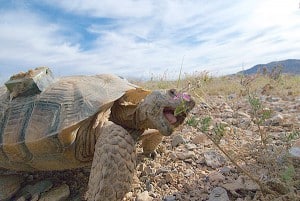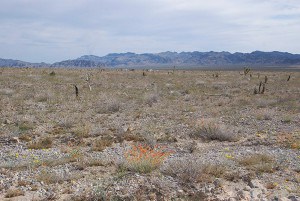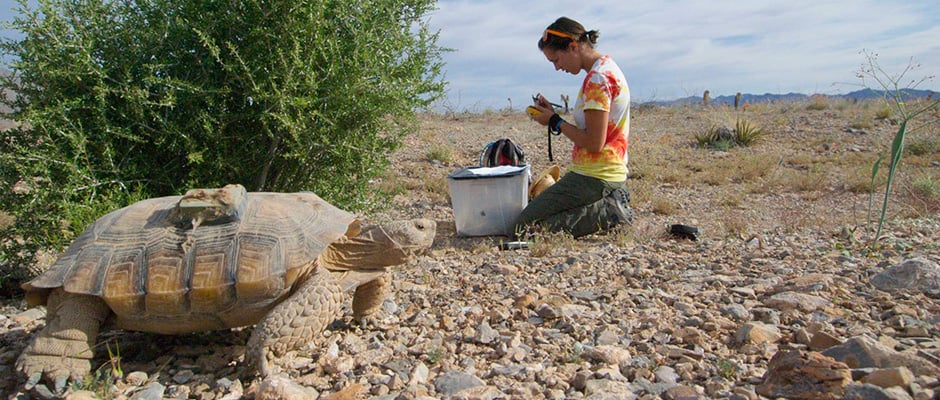Share this article
Threatened Desert Tortoises Good at Weathering Wildfires
The wildfires occurring with increasing frequency in the Mojave Desert don’t have much of an effect on desert tortoises, according to new research.
“The thing about tortoises is they’re resilient and they rarely behave like we expect they’re going to behave,” said Todd Esque, member of The Wildlife Society, research ecologist with the U.S. Geological Survey and coauthor of a recent study published in The Journal of Wildlife Management.

An Agassiz’s desert tortoise (Gopherus agassizii) feeds on Erodium cicutarium in the Hidden Valley study area that was burned in a fire in 2006. A new study finds that fires may not affect the sustainability of tortoise habitat too much.
Image Credit: Todd C. Esque, USGS
Fire has had a huge influence on tortoise habitat in the Mojave over the past 30 years, Esque said. In fact, the Agassiz’s desert tortoise (Gopherus agassizii), listed as threatened under the Endangered Species Act, subsists mostly on herbaceous plants and wildflowers that grow in the desert and burn in wildfires.
Esque said the team wanted to do research on what happened to desert tortoises right after a fire because the “wheels of bureaucracy don’t move fast enough to be responsive.” Most turtles managed to weather the actual flames fairly well due to the fact they spend much of their time underground, though about 12 percent were killed in the fire itself. In particular, the team wanted to see how desert tortoises used the changed landscapes after the fire, and went into the Mojave in southern Nevada after a fire in 2005 to see what happened.
They found that some tortoises seemed to make good use of the areas around the edge of the burned desert, taking advantage of globemallow (Sphaeralcea ambigua) that popped up when the larger shrubs were burned off. What seemed odd was that the turtles appeared to be going deeper into the burned area every year for five years after which they dropped back. But, consultation with a plant ecologist revealed that the globemallow flowers the tortoises had a taste for died back a little toward the end of the five years, and could have pushed the turtles out of the area.

Globemallow blooms in the foreground in the Hidden Valley study area that was burned in a fire in 2006. Researchers found that this plant recovered quickly after wildfires in the Mojave Desert, drawing turtles into the area for foraging.
Image Credit: Todd C. Esque, USGS
“It really filled a big gap to help us understand what was going on,” Esque said of speaking to the ecologist.
Esque is also working on an unpublished study that tracks the effects of fire on a closely related tortoise subspecies, Morafka’s desert tortoise (Gopherus morafkai), in the Sonoran Desert. Roughly the same number of tortoises died there in the region’s wildfires, but those tortoises seemed to do better afterwards, partly due to a larger amount of rainfall in the area that helps plants recover more quickly.
Different landscape features such as boulders also help the Morafka’s tortoises in the Sonoran, but the burning of features like giant saguaro cacti (Carnegiea gigantea), which take hundreds of years to grow, could may have negative impacts on the habitats in the long-term.
More long-term studies are needed to assess the effects wildfires have on tortoises. But Esque said that the fact that tortoises still use burned areas of deserts is important in terms of addressing the value of land for the species in the face of competition from stakeholders who would like to use the areas for energy production, power lines, military training or other purposes. “The most important finding is that it means that the property still has value as [tortoise] habitat in regards to land management,” he said.
Header Image:
USGS researcher Sydney Kelley collects data on a Mojave desert tortoise in the Hidden Valley study area that was burned in a fire in 2006.
Image Credit: Todd C. Esque, USGS








